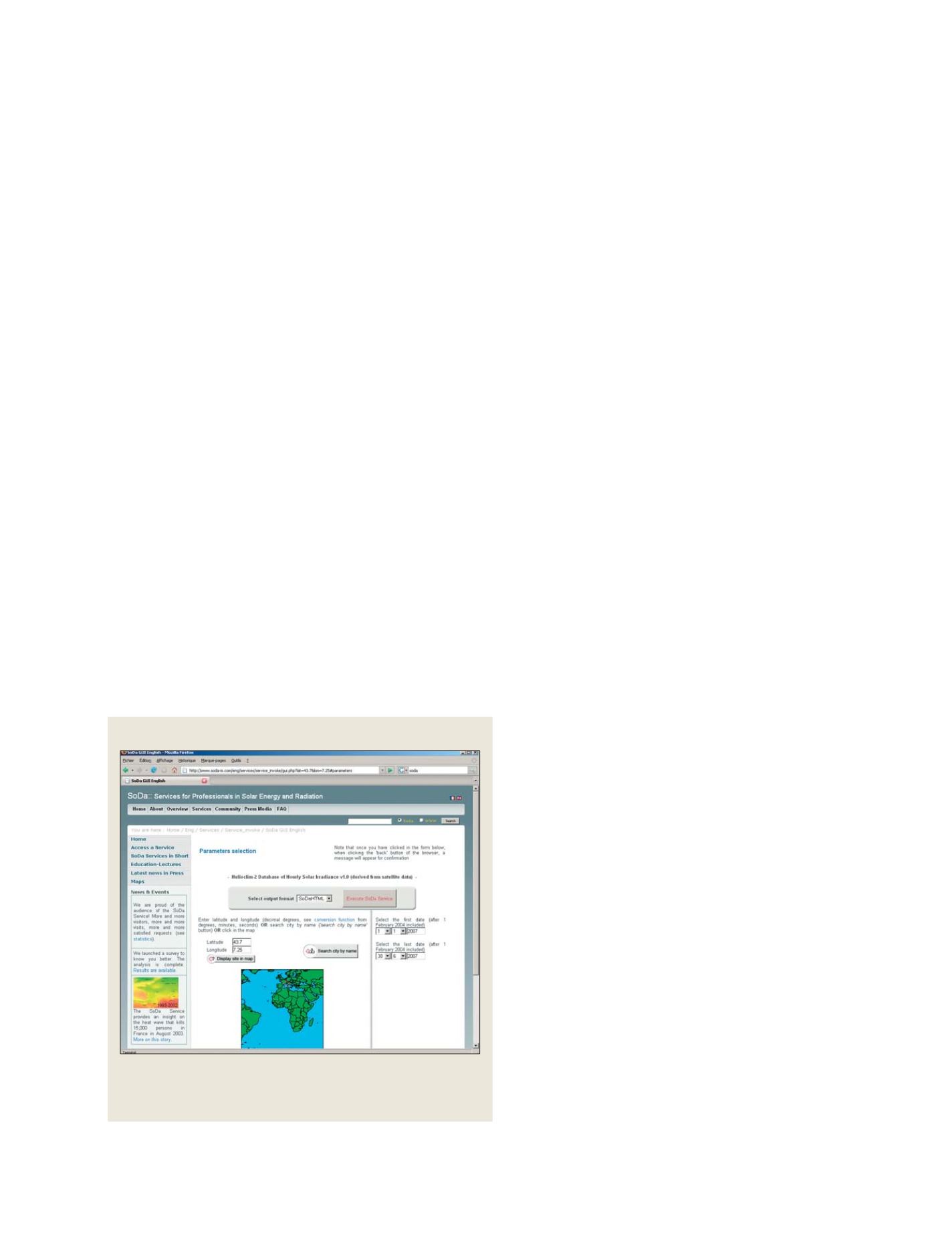

“In developing countries all over the world we have removed some
of the uncertainty about the size and intensity of the solar and wind
resource,” says Klaus Toepfer, former executive director for Solar and
Wind Energy Resource Assessment (SWERA)
3
at the United Nations
Environment Programme (UNEP). “These countries need greatly
expanded energy services to help in the fight against poverty and to
power sustainable development. SWERA offers them the technical
and policy assistance to capture the potential that renewable energy
can offer,” he says. “As energy planners seek cleaner energy solu-
tions using renewable energy technologies, the availability of reliable,
accurate and accessible solar and wind energy information is criti-
cal and can significantly accelerate the deployment of these
technologies. In the case of renewable energy, knowledge is literally
power”.
Peter Toggweiler of Enecolo AG tells of its problems with plant
monitoring: “As an engineering consultant, Enecolo AG is mandated
to monitor more than 30 PV plants with a total installed power of
about 2.5 MW. The PV plants are distributed all over Switzerland
and the southern part of Germany, and differ widely in installed
power, module types, inverters and monitoring procedure. Most PV
systems are provided with a device that allows connection to the
inverter. But for each type of inverter, another software and data
logger is needed and a different type of data is provided.
“For most PV systems we receive the monthly energy yield via fax
or e-mail. All these data are then manually collected and analysed.
This procedure is very time consuming and ineffective. As we only
receive monthly data, it can be 31 days before we recognize a
malfunction. Failures that don’t lead to a complete outage but only
to a minor reduction of the energy yield are often not detected at all,
or only after several months. With a satellite-based service, plant
monitoring will be facilitated and more efficient: hourly data of the
energy yield of the PV plant is automatically collected on the server
and delivered to the operators of the PV system through
the Internet. Thus, no time-intensive manual collection
of the data is necessary. The data is updated every day,
so it is possible to detect malfunctions within one day
instead of within one month”.
Dr Henner Gladen of Solar Millennium AG, a German,
global-oriented technology and service company, says:
“Solar radiation time series delivered by DLR were used
in the planning of eight projects, with a total peak power
of 360 MW. This corresponds to an estimated invest-
ment of about EUR1,400 million. Solar Millennium AG
is planning further large solar thermal power plants
worldwide. The field of large solar thermal power plants
is an evolving market with projected worldwide invest-
ment to the order of some EUR10 billion over the next
ten years. To improve economical analysis we want to
make further use of satellite based solar irradiance data.
It allows us to receive reliable maps showing the distri-
bution of solar energy in regions of interest, for use in
further projects.”
Mathieu Sarran from German company Lahmeyer
International, which provides technologies for energy
infrastructure development, says: “Our consulting activ-
ities on rural electricity provision by means of solar
energy require accurate data on solar radiation. In Africa,
such data are inexistent in under-developed regions.
Accordingly, Lahmeyer International installs its own
measuring stations. The availability of radiation data
that can be accessed through the SoDa service is a real
advantage for our company.
“The first benefit is that they are available at any site:
there are more data than we can install stations. The
second benefit is that archives are available instanta-
neously while our measuring stations need to work two
full years before delivering a consistent and reliable time
series. Advantages include fast access to information,
reliability of information, large geographical coverage
and the dramatic decrease of costs for study and plan-
ning. By exploiting these data, projects can be realized
more quickly, more reliably, more completely and more
competitively.”
The future of solar energy resources
Earth observation satellites have proven to be a valuable
tool for the optimum use of solar energy resources.
Satellites and ground measurements are excellent part-
ners for providing dedicated services, with satellites
allowing services on a large regional scale. Both indus-
trialized and developing countries are covered by the
same satellite technology and can profit from each other.
Various user statements both from the industrial and
public sectors show the benefits of solar energy resources
already exist. Nevertheless, realizing the full potential
of the GEOSS system requires further collaboration
between users and information providers to enable
global data access and improved data accuracy. In partic-
ular, new approaches in data policy and long-term
maintenance of databases, archives and access infra-
structure are needed in the GEOSS framework.
[
] 201
SoDa interface
The SoDa web interface enables automatic access to both the Ecole des
Mines des Paris Helioclim database and the Surface Meteorology and Solar
Energy NASA data set
Source:
www.soda-is.comS
OCIETAL
B
ENEFIT
A
REAS
– E
NERGY
















